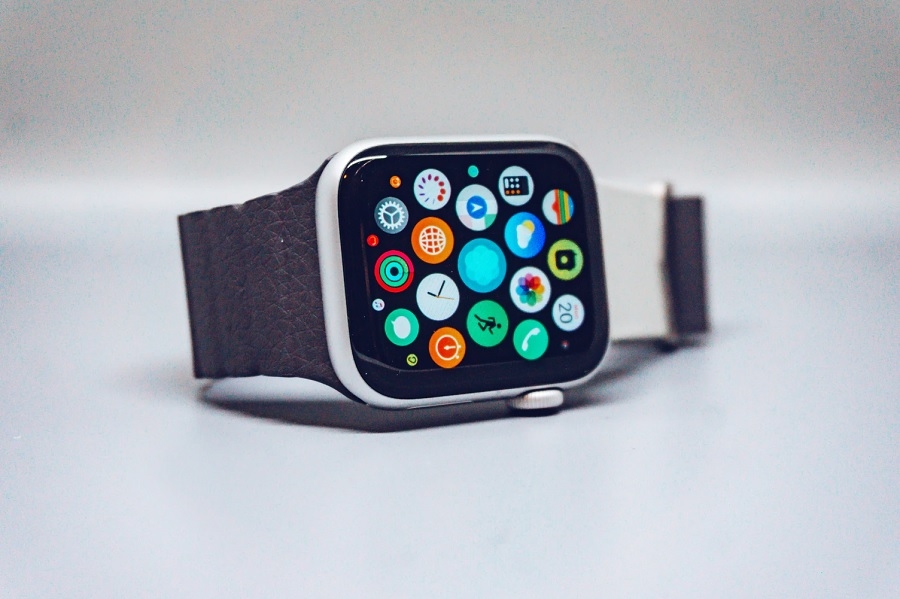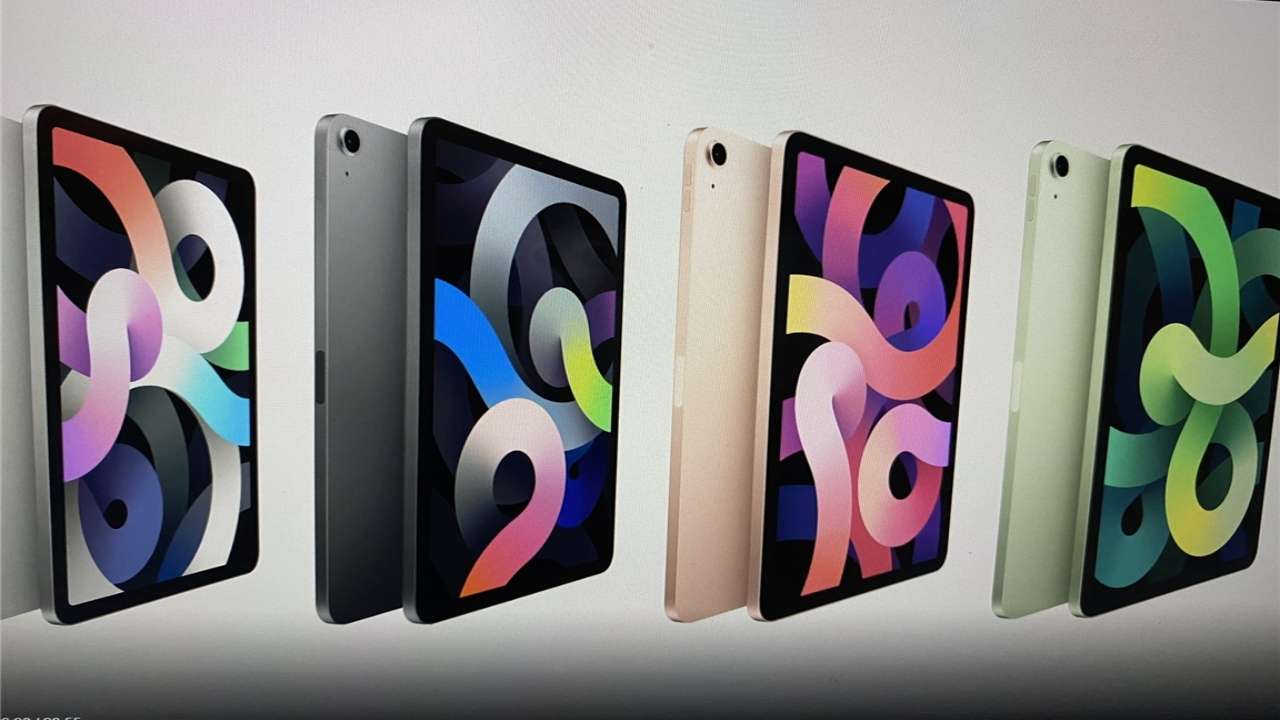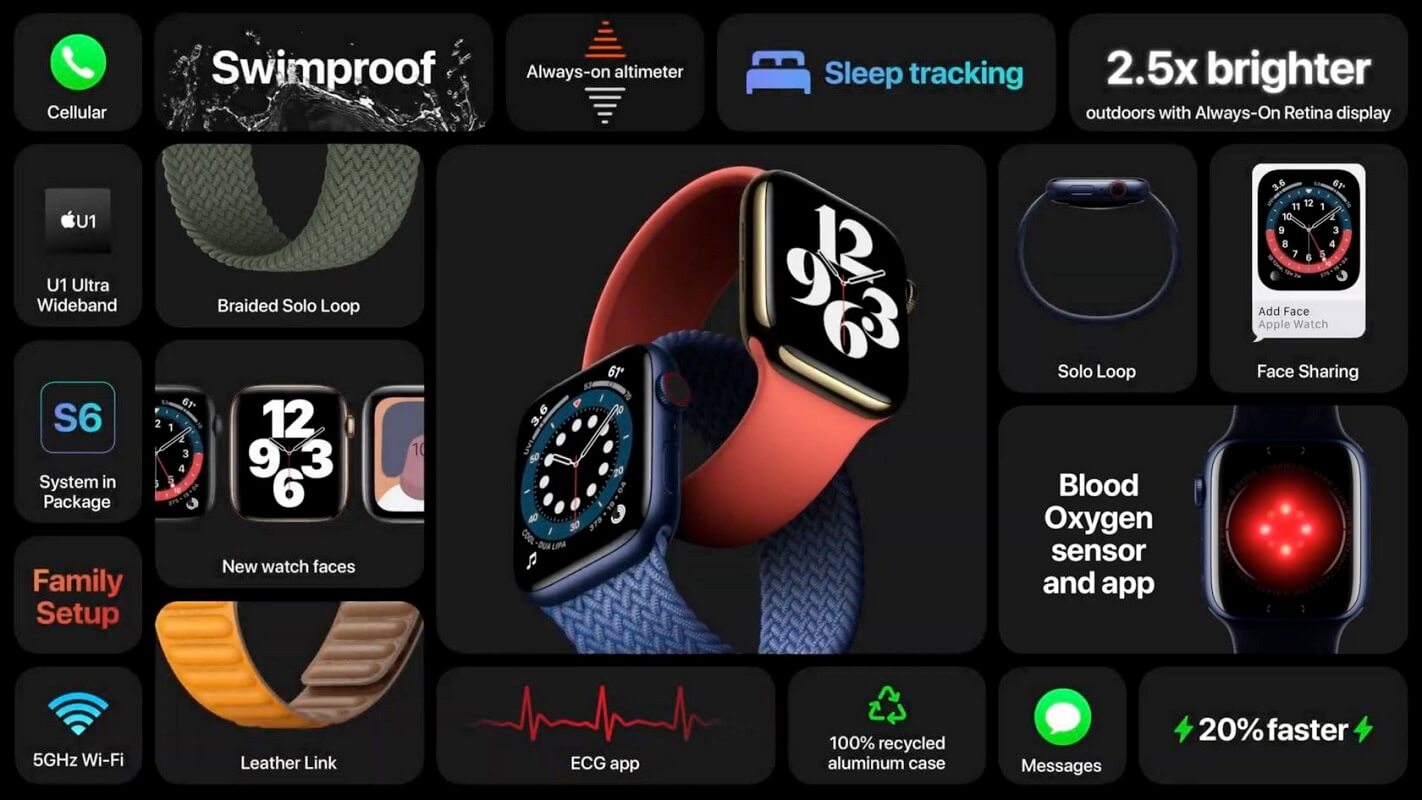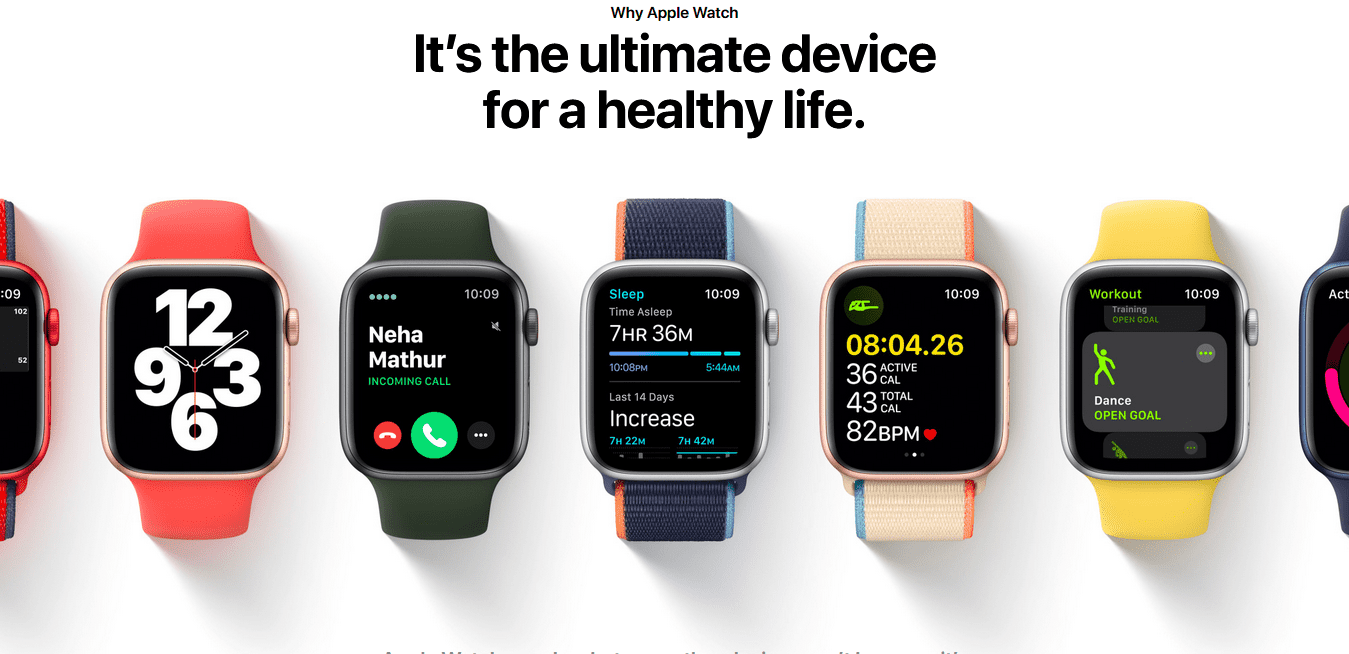The Apple Watch Series 7 offers the same suite of sensors as the Series 6. These include an accelerometer, a gyroscope, a heart rate sensor, a barometer, an always-on altimeter, a compass, an SpO2 sensor, and a VO2 max sensor. These sensors have a host of health and fitness tracking features, including blood oxygen monitoring, heart rate monitoring, sleep tracking, fall detection, workout tracking, and more. The biggest difference is that the Watch SE does not have a blood oxygen monitoring support and an ECG monitor like Apple Watch Series 6. But both the watches have varied sensors like GPS/GNSS, compass, always-on altimeter, second-gen optical heart rate sensor, accelerometer, gyroscope, and ambient light sensor. The altimeter in the watch enables the user to see metrics like distance, pace, laps, cadence, calories burnt, and heart rate when you raise your wrist.
So, if don't need advanced health features, Apple Watch SE might suit your better as it has adequate health monitoring capabilities. The new Apple Watch 6 features a number of improvements which includes a faster S6 chipset and next-gen always-on altimeter. One of the highlights of the device is its new heart rate sensor, which can be used to measure blood oxygen saturation . The new flagship wearable also comes with an advanced Retina display, accelerometer, gyroscope, and the latest motion sensors. The Apple Watch 6 also has a 2.5x brighter display as compared to its predecessor.
The Apple Watch Series 7 offers the same health monitoring features available with the Series 6. A built-in accelerometer and gyroscope enable other important health-related features such as fall detection. While it's no longer officially a part of Apple's wearable lineup, you can still buy the Apple Watch Series 6 at several retailers.
The Apple Watch comes in two sizes, 40mm and 44mm, which start at $399 and $429, respectively. The Series 6 features built-in sleep tracking, a great ecosystem of third-party complications, and more sensors than previous models, including one that allows the device to detect your body's blood oxygen levels. Additional features include a new S6 processor that is up to 20% faster than the S4 and S5, a 2.5× brighter always-on display, and an always-on altimeter. The S6 incorporates an updated, third generation optical heart rate sensor and also enhanced telecommunication technology, including support for ultra-wideband via Apple's U1 chip, and the ability to connect to 5 GHz Wi-Fi networks. The Series 6 watch was updated with faster charging hardware such that it completes charging in ~1.5 hours.
Apple Watch 6 Available Date In India Force Touch hardware was removed, consistent with the removal of all Force Touch functionality from watchOS 7. It also works like an iPhone with numerous features like maps, app store, siri, apple music, text, make calls, sleep app and more. Get a healthy number of workouts, make a splash with your watch, check your heart rate, measure your blood oxygen levels, and generate ECG on your wrist. That said, if the $399 starting price is out of your budget, the new Apple Watch SE offers many of the same features as the Series 6—including a handwashing timer, sleep tracking, heart rate notifications, and more—for $120 less. It lacks an always-on display and some of the Series 6's more advanced health features, however, including the ability to take an ECG and measure the oxygen saturation of your blood. It's a strong alternative to the Series 6 if you don't mind a less health-focused experience.
The Watch SE, which shares design elements with the Series 6, along with key health and safety features like fall detection, starts at $279 for the GPS-only model or $329 for the GPS and cellular version. It lacks an always-on display, as well as blood oxygen saturation and electrocardiogram readings—we go into detail on the differences between the two watches here. The Apple Watch has been our longstanding Editors' Choice for its excellent performance, unparalleled app selection, and ample health and fitness tracking features. Apple Watch Series 6 comes with numerous features which not only mrake its appearance appealing but also very adjustable. The phone has a dimension of 44 x 38 x 10.4 mm (1.73 x 1.50 x 0.41 in) with a weight of 47.1 g (1.66 oz) Comfortable to move around. Moreover the build of Apple Watch Series 6 is Glass front , ceramic/sapphire crystal back, stainless steel frame .
It supports eSIM 50m water resistant ECG certified (region dependent SW application; HW available on all models) option through you can get accessibility to different networks. The Apple Watch Series 6 sensors include Accelerometer, gyro, heart rate , barometer, always-on altimeter, compass, SpO2, VO2max . There are some tradeoffs with the Apple Watch Series 3 because it is a much older model, such as a smaller display, an older chipset, and the lack of a compass, fall detection, ECG, and blood oxygen monitoring. This new Apple Watch also shares the same sensor as last year's, so you'll have to wait for the hotly anticipated blood pressure and glucometers features in Apple Watch Series 8 .
However, you can still track your blood oxygen levels, ECG and heart rate, so it's still a solid smartwatch for fitness buffs. There's also a new mindfulness app, cycling fall detection and calorie burning calculator, which overall makes this the best Apple Watch to date. Apple's latest smartwatch is mostly an incremental upgrade from the Apple Watch 6, maintaining an 18-hour battery life, the same CPU and adding no new health features. But the enlarged display is game-changer, and makes it difficult to return to previous-generation models.
The Series 7's big screen adapts wearable computing for more everyday applications, making it practical to be productive from your wrist. The Apple Watch Series 6 is powered by the new S6 SiP and offers new hardware and software features. You get a brand new SpO2 sensor for blood oxygenation levels and VO2 MAx readings from workouts. Thanks to the new SiP we also get fast-charging of the Apple Watch for the first time, topping the battery from 5 percent to full in about 90 minutes. The Apple Watch is one accurate device when it comes to tracking different forms of workouts, recording the duration, effort and heart-rate related metrics with great accuracy. As far as the Apple Watch's smart capabilities are concerned, the app ecosystem for the Watch has come a really long way, allowing the watch to be a seamless extension of your iPhone.
It easily outperforms Google Wear OS-based watches like the Moto 360, and offers a much more fully realized smartwatch experience than Fitbit's more health-centric models. If you already own a Series 5, the Series 6 is really only worth the upgrade if you absolutely must have the always-on altimeter or SpO2 readings. But between its advanced health and fitness monitoring capabilities, safety and lifestyle features, and wide selection of downloadable apps, the Apple Watch Series 6 is the best smartwatch on the market hands down, and our Editors' Choice. In the past, Apple's watchOS looked similar across all its smartwatches, minus select apps exclusive to the new hardware inside a given model. Apple Watch 7 doesn't have new sensors, though, so instead the company altered watchOS 8 for a bigger screen. Apple also launched a more affordable Apple Watch called Watch SE. It features a retina display and is powered by S5 dual-core SiP.
It comes with features like fall detection, sleep tracker, handwash reminders, emergency SOS and so on. The workout modes include running, walking, yoga, cycling, high-intensity interval training, and dance. It will show you details like distance, pace, laps, cadence, calories burned, and heart rate.
Apple Watch Series 4, which launched a year later, featured a major redesign with a screen that was 30% bigger in both models and a 50% improvement on its processor over the Series 3 version. Speakers and microphones were rearranged so they were louder and more useful, and Series 4 introduced the fall detection feature, ECG capabilities, and the second-generation heart rate monitor. All Apple Watch Series 7 models feature a black ceramic and crystal back that houses four LED clusters and four photodiodes to facilitate health-monitoring features such as heart rate monitoring, blood oxygen monitoring, and ECGs. The Apple Watch Series 7, announced in September 2021, is the current iteration of the Apple Watch that originally launched in 2015 and replaced the Series 6. The Apple Watch Series 7 builds on the design of previous Apple Watch models with a more rounded design and offers some notable new features including larger displays, improved durability, and faster charging.
Initial reviews for the device have been generally positive with some caveats. Reviewers praised the watch's potential ability to integrate into everyday life and the overall design of the product, but noted issues of speed and price. Many reviewers described the watch as functional and convenient, while also noting failure to offer as much potential functionality as preceding smartphones. Farhad Manjoo of The New York Times mentioned the device's steep learning curve, stating it took him "three long, often confusing and frustrating days" to become accustomed to watchOS 1, but loved it thereafter. Some reviewers also compared it to competing products, such as Android Wear devices, and claimed "The Smartwatch Finally Makes Sense".
He concluded that there is no "killer application" so far besides telling the time, which is the basic function of a wristwatch anyhow. The Series 6 has all the excellent health, safety, and lifestyle features of its predecessor. These include ECG readings, high and low heart rate notifications, irregular heart rhythm notifications, menstrual cycle tracking, fall detection, high decibel alerts, emergency SOS, and international emergency calling. The watch's Move, Exercise, and Stand rings are a personal favorite, as they help motivate me to stay active on a regular basis and cheer me on when I do. Apple is late to the game with sleep tracking capabilities, as most smartwatches and fitness trackers already offer this feature, and Apple's version is still pretty basic. After you wear the Apple Watch to bed, the Health app on your iPhone shows when you fell asleep, woke up, and your total time in bed and asleep for the night.
It also shows a graph of your heart rate, with your maximum and minimum recorded beats per minute. It charts your sleep for the week and month, and shows your average time in bed and average time asleep. The new Apple Watch Series 6 takes things ahead from Series 5, while the Watch SE becomes a more affordable option for the masses. The Watch Series 6 essentially comes with a similar design and size as the Series 5 but you now get the ability to monitor your blood oxygen.
You continue to get an ECG monitor along with a variety of improvements in the display brightness, core performance thanks to the new chipset, and the addition of a real-time altimeter. There is also an improved sleep tracker, a variety of new and useful watch faces and various strap and colour options including a new blue colour and the first-ever Product Red edition. There is also watchOS 8 that brings features such as the new Mindfulness app to help users reduce their stress levels. The Apple Watch Series 7 is said to deliver 18-hours of battery life on a single charge.
Each model through Series 3 comes in a 38- or 42-millimeter body, with the larger size having a slightly larger screen and battery. The Series 4 was updated to 40- and 44-millimeter models, respectively. Featured Apple-made bands include colored sport bands, sport loop, woven nylon band, classic buckle, modern buckle, leather loop, Milanese loop, and a link bracelet.
WatchOS 3.0 was announced at WWDC 2016, with a priority on performance. Users are able to keep apps running in memory as well as receive background updates and refreshed information. Other updates include a new Dock invoked with the side button to replace the performance-laden Glances, an updated Control Center, and new reply options on Messages. Several new watch faces have also been added, including Minnie Mouse, along with the ability to switch watch faces from the lock screen simply by swiping. A new app called Breathe guides users through breathing exercises throughout the day, with visuals and haptic feedback. TechRadar gave it a score of 4.5/5, calling it one of the top smartwatches, while criticizing the short battery life.
Digital Trends gave it a score of 5/5, calling it Apple's best product and praising the design, build quality, and software, among others, while criticizing the battery life. CNET gave it a score of 8.2/10, calling it the "best overall smartwatch around", while criticizing the battery life and lack of watch face options. T3 gave it a score of 5/5, calling it a "truly next-gen smartwatch" due to its thinner body and bigger screen compared to the Series 3, and health features.
Additional sensors integrated into the Watch include an accelerometer, gyroscope, and barometer, which are used to determine device orientation, user movement, and altitude. The back of all Apple Watches is equipped with a Heart Rate Monitor, which projects infrared and green light from light-emitting diodes onto the user's skin and photodiodes measure the varying amount of light reflected. Because blood absorbs green light and reflects red light, the amounts of each type of reflected light are compared to determine heart rate. A blood oxygen monitor was added with the Series 6 in 2020, albeit as a "wellness" device not capable of diagnosing a medical condition. The blood oxygen monitor added red LEDs to the back, allowing the watch to determine oxygen levels by measuring blood color.
The Watch SE reverted to the capabilities of the Series 3, dropping the electrical sensors and blood oxygen monitor. In comparison to other Apple products and competing smartwatches, marketing of the Apple Watch promoted the device as a fashion accessory. Apple later focused on its health and fitness-oriented features, in an effort to compete with dedicated activity trackers. The watchOS 3 added fitness tracking for wheelchair users, social sharing in the Activity app, and a Breathe app to facilitate mindfulness. The new Apple Watch Series 6 is powered by an S6 chip and lets you monitor blood oxygen levels. This blood oxygen tracker is a feature of watchOS 7 that will release tomorrow.
The smartwatch also comes with features like an always-on display, sleep tracking, automatic handwashing detection and more. While all of the Apple Watch models and colorways covered here are encased in aluminum, Apple does make a more premium range built out of stainless steel and titanium. These offerings have similar designs to their aluminum counterparts, with slightly refined colors and finishings — polished for the stainless steel, brushed for the titanium. However, they start at much steeper prices of $749 and above, and they are functionally the same, save for some exclusive digital watch faces Apple reserves for these premium models. Overall, the upmarket stainless, titanium, and Hermès edition Apple Watches also don't usually get the discounts and sales as the aluminum models. Unlike any other smartwatch, Apple Watch Series 6 has an iconic design, always-on large Retina display and unmatched advanced features.
What makes this Apple Watch stand out from any other smartwatch is its revolutionary new sensor and app that can help measure the blood oxygen level anytime. Users can take an ECG, an electrocardiogram which represents the electrical pulses that make your heart beat with the remarkable new sensor and ECG app. While the Apple Watch remains one of the standout wearables you can buy, we're still waiting for another leap forwards in functionality and, perhaps, design too. The blood oxygen monitor is another weapon in the arsenal of health Apple is building, but isn't the headline feature most potential upgraders will be clamoring for.
As ever, the incremental improvements to the battery life and display are welcome, but it feels like there's untapped potential still with Apple's wearable line. It has a dual-core processor, which is claimed to deliver 20% faster performance than Series 5. The apps launch quite quickly on the Series 6 and it does have a snappier feel to it.
It doesn't last an entire day, the best we could get was close to 17 hours and then you just have to charge it. What's improved is fast charging as it was one of our tiny grouse with Apple on the Watch. The Watch Series charges completely in just about 90 minutes while it recaches zero to 80% in an hour. The biggest new feature in the Apple Watch Series 6 is the blood oxygen monitoring. Apple clearly states on its website that this isn't a tool intended for medical purpose and is certainly not an indicator of whether a person is infected by coronavirus or not. The feature works through a blood oxygen sensor, just like a pulse oximeter.
What it does it checks if your blood oxygen saturation levels are fine or not. There's a dedicated app on Watch which takes about 15 seconds to show the results. You've to keep your wrist steady and on a flat surface to get accurate results. The Watch Series 6 also keeps taking measurements routinely in the background — even when you are sleeping.
If you open the app on the Watch, then you can see the most recent reading. It's a nice health feature to have on the Watch but we aren't sure if it's a compelling one to make a case, say over the Watch SE. The Apple Watch Series 6 looks pretty much similar to Watch Series 5 — except for new colours. Apple has added red and blue colours to the Watch and rest everything looks pretty much same. Except a new sensor has been added to the at the back of the Apple Watch, which measures blood oxygen levels — the highlight feature of Series 6. What's new are also two strap designs — Solo Loop and Braided Solo Loop — but they don't ship with the Apple Watch.
The blue colour variant that we got to review is really pretty looking. With the right strap, you can make it look sporty and classy at the same time. The Digital Crown and the single button continue to serve their purpose and the Watch is available in 40mm and 44mm sizes. After testing the beta version of watchOS 7 on my Series 5 for more than a month, the handwashing countdown timer has become a necessity in my life, especially in light of COVID-19. The watch uses motion sensors to detect handwashing movements and the microphone to listen for the sound of running water.
When it detects that you're washing your hands, it displays a 20-second timer on the screen, so you don't have to silently hum Happy Birthday twice in your head. When you're done, the watch slightly vibrates and gives you a thumbs up on the screen. Apple has also made some significant improvements to battery life and charging on the Apple Watch Series 7.
The company claims that the new smartwatches offer 18-hour all-day battery life, along with 33% faster charging than the previous model. The Apple Watch Series 7 launch date is inching closer, promising to be a significant upgrade for those using older models and waiting for something new. Some of the expected improvements include better battery life, a flat edge design similar to the iPhone 12 series and new health features.





























